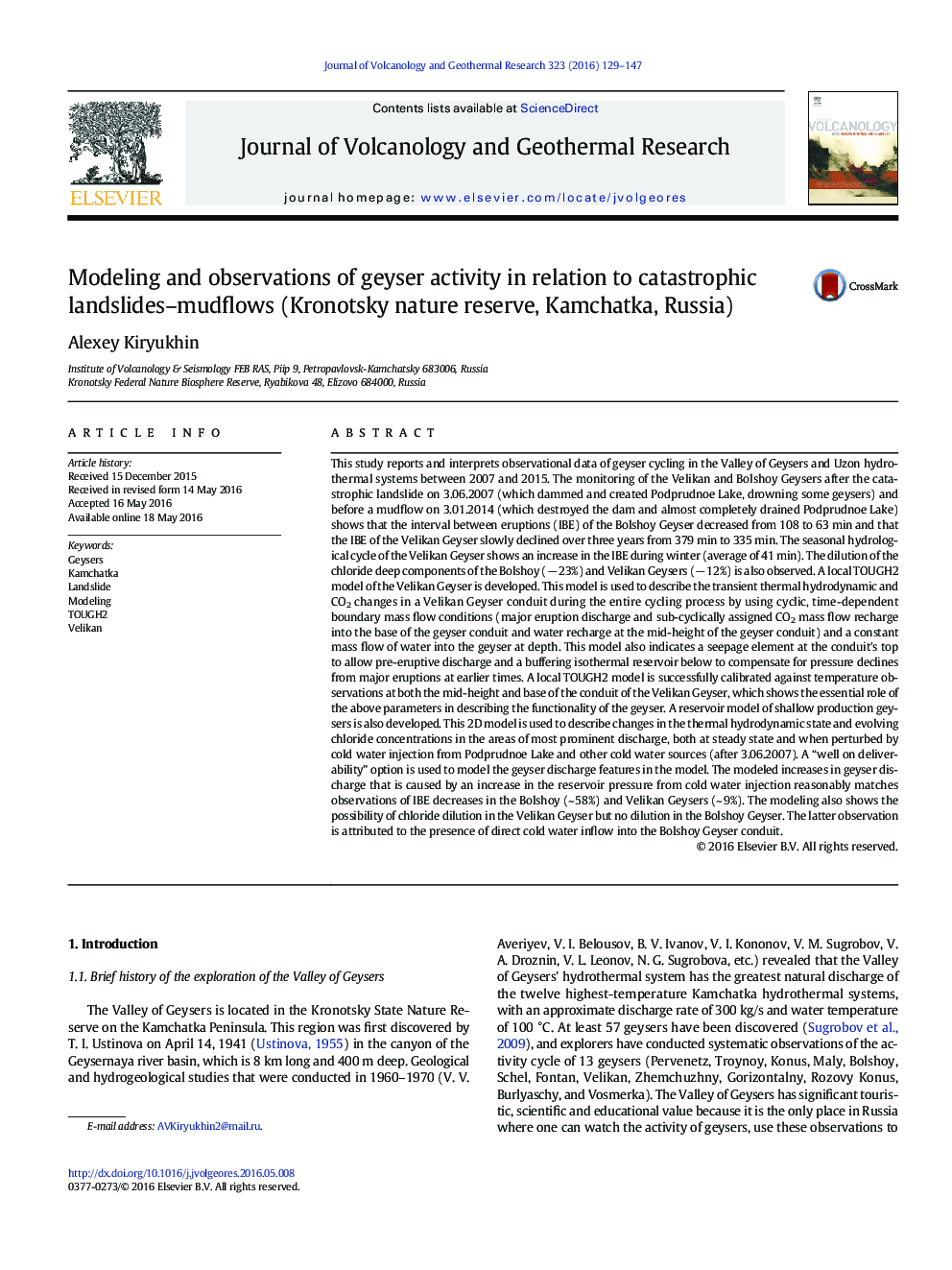| کد مقاله | کد نشریه | سال انتشار | مقاله انگلیسی | نسخه تمام متن |
|---|---|---|---|---|
| 4712655 | 1638299 | 2016 | 19 صفحه PDF | دانلود رایگان |
• Velikan and Bolshoy Geysers showed that Interval Between Eruptions (IBE) are sensitive to giant landslides and seasonal events.
• A local TOUGH2 model demonstrated the essential role of CO2 cyclic flux in regulating the eruption periodicity.
• The modeled geyser discharge increased due to cold water injection from Lake is matched the observed geyser IBE decreases.
This study reports and interprets observational data of geyser cycling in the Valley of Geysers and Uzon hydrothermal systems between 2007 and 2015. The monitoring of the Velikan and Bolshoy Geysers after the catastrophic landslide on 3.06.2007 (which dammed and created Podprudnoe Lake, drowning some geysers) and before a mudflow on 3.01.2014 (which destroyed the dam and almost completely drained Podprudnoe Lake) shows that the interval between eruptions (IBE) of the Bolshoy Geyser decreased from 108 to 63 min and that the IBE of the Velikan Geyser slowly declined over three years from 379 min to 335 min. The seasonal hydrological cycle of the Velikan Geyser shows an increase in the IBE during winter (average of 41 min). The dilution of the chloride deep components of the Bolshoy (− 23%) and Velikan Geysers (− 12%) is also observed. A local TOUGH2 model of the Velikan Geyser is developed. This model is used to describe the transient thermal hydrodynamic and CO2 changes in a Velikan Geyser conduit during the entire cycling process by using cyclic, time-dependent boundary mass flow conditions (major eruption discharge and sub-cyclically assigned CO2 mass flow recharge into the base of the geyser conduit and water recharge at the mid-height of the geyser conduit) and a constant mass flow of water into the geyser at depth. This model also indicates a seepage element at the conduit's top to allow pre-eruptive discharge and a buffering isothermal reservoir below to compensate for pressure declines from major eruptions at earlier times. A local TOUGH2 model is successfully calibrated against temperature observations at both the mid-height and base of the conduit of the Velikan Geyser, which shows the essential role of the above parameters in describing the functionality of the geyser. A reservoir model of shallow production geysers is also developed. This 2D model is used to describe changes in the thermal hydrodynamic state and evolving chloride concentrations in the areas of most prominent discharge, both at steady state and when perturbed by cold water injection from Podprudnoe Lake and other cold water sources (after 3.06.2007). A “well on deliverability” option is used to model the geyser discharge features in the model. The modeled increases in geyser discharge that is caused by an increase in the reservoir pressure from cold water injection reasonably matches observations of IBE decreases in the Bolshoy (~ 58%) and Velikan Geysers (~ 9%). The modeling also shows the possibility of chloride dilution in the Velikan Geyser but no dilution in the Bolshoy Geyser. The latter observation is attributed to the presence of direct cold water inflow into the Bolshoy Geyser conduit.
Journal: Journal of Volcanology and Geothermal Research - Volume 323, 1 September 2016, Pages 129–147
